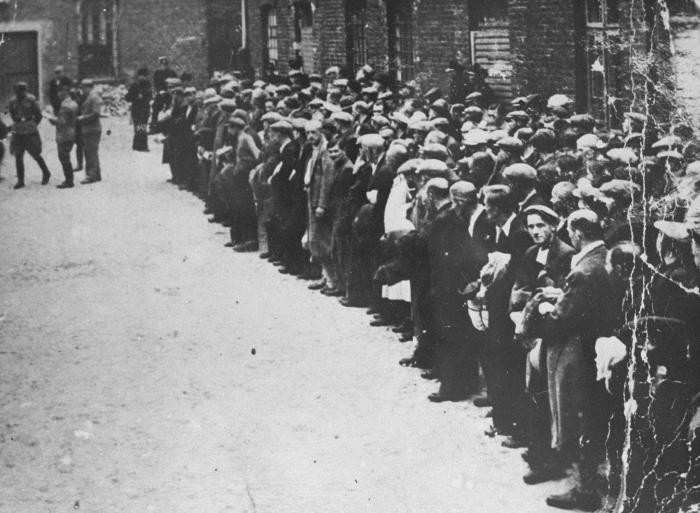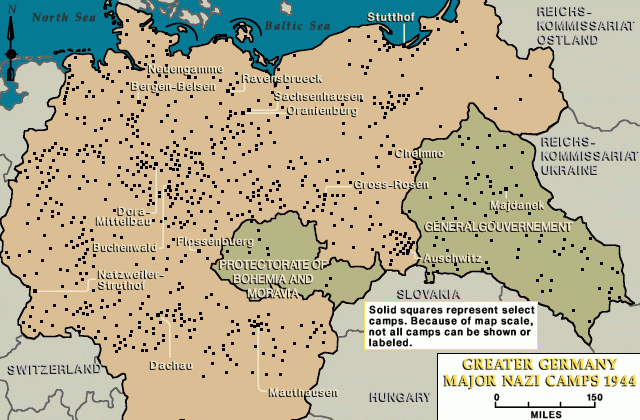
Sachsenhausen
Between 1933 and 1945, Nazi Germany and its allies established more than 44,000 camps and other incarceration sites (including ghettos). The perpetrators used these locations for a range of purposes, including forced labor, detention of people deemed to be "enemies of the state," and mass murder. Millions of people suffered and died or were killed. Among these sites was the Sachsenhausen camp and its subcamps.
The SS established the Sachsenhausen concentration camp as the principal concentration camp for the Berlin area. Located near Oranienburg, north of Berlin, the Sachsenhausen camp opened on July 12, 1936, when the SS transferred 50 prisoners from the Esterwegen concentration camp to begin construction of the camp.

Prisoners in the Camp
In the early stage of the camp's existence the SS and police incarcerated mainly political opponents and real or perceived criminal offenders in Sachsenhausen. By the end of 1936, the camp held 1,600 prisoners. Between 1936 and 1945, however, Sachsenhausen also held Jews, gay men, Jehovah's Witnesses, "asocials" (among these prisoners were Roma and Sinti), and, later, Soviet civilians. Prominent figures interned in Sachsenhausen included Pastor Martin Niemöller, former Austrian chancellor Kurt von Schuschnigg, Georg Elser, Herschel Grynszpan, and Joseph Stalin's son, Yakov Dzhugashvili.
The number of Jewish prisoners in Sachsenhausen varied over the course of the camp's existence, but ranged from 21 at the beginning of 1937 to 11,100 at the beginning of 1945. During the nationwide Kristallnacht ("Night of Broken Glass") pogrom of November 1938, Reichsführer SS (SS chief) and Chief of German Police Heinrich Himmler ordered the arrest of up to 30,000 Jews. The SS transported those arrested to Sachsenhausen, Dachau, and Buchenwald concentration camps. Almost 6,000 Jews arrived in Sachsenhausen in the days following the Kristallnacht riots.
In the following months, the number of Jews at Sachsenhausen steadily decreased, as SS authorities released Jewish prisoners, often in exchange for a stated intent to emigrate. By the end of 1938, Sachsenhausen held 1,345 Jews.
There was another marked increase in the number of Jewish prisoners when, in mid-September 1939, shortly after World War II began, German authorities arrested Jews holding Polish citizenship and stateless Jews, most of whom were living in the greater Berlin area, and incarcerated them in Sachsenhausen. Thereafter, the number of Jewish prisoners decreased again, as SS authorities deported them from Sachsenhausen to other concentration camps in occupied Poland, most often Auschwitz, in an effort to make the so-called German Reich "free of Jews" (judenfrei).
By autumn of 1942 there were few Jewish prisoners still in Sachsenhausen, and their numbers remained low until 1944. In the spring of 1944, SS authorities began to bring thousands of Hungarian and Polish Jews from ghettos and other concentration camps to Sachsenhausen as the need for forced laborers in Sachsenhausen and its subcamps increased. Many of these new Jewish prisoners were women. By the beginning of 1945 the number of Jewish prisoners had risen to 11,100.
Following anti-German demonstrations in Prague in November 1939, German authorities incarcerated some 1,200 Czech university students in Sachsenhausen. In total, German authorities deported over 6,000 people from the annexed Czech provinces to Sachsenhausen.
German forces in Poland shot or deported to concentration camps thousands of Poles, especially teachers, priests, government officials, and other national and community leaders, in an attempt to eliminate the Polish educated elite and thereby prevent organized resistance to German rule in Poland. The German authorities sent some of these Poles to Sachsenhausen. On May 3, 1940, for example, 1,200 Polish prisoners arrived in Sachsenhausen from the Pawiak prison in Warsaw. The prisoners included many juveniles, Catholic priests, army officers, professors, teachers, doctors, and minor government officials.
The first group of Soviet prisoners of war arrived in Sachsenhausen at the end of August 1941. By the end of October 1941, the SS had deported about 12,000 Soviet prisoners of war to Sachsenhausen. Camp authorities shot thousands of the Soviet POWs shortly after they arrived in the camp. Estimates of Soviet POWs killed at Sachsenhausen range from 11,000-18,000.
In retaliation for the August 1944 Polish Home Army uprising in Warsaw, the German authorities expelled most of the Polish population from the city. The Germans deported 60,000-80,000 Polish civilians to concentration camps. By early October 1944, the Germans had deported about 6,000 Poles to Sachsenhausen.
SS Personnel
In November 1936, the camp headquarter's staff of the Sachsenhausen concentration camp consisted of 70 SS personnel; by 1944 this number had reached 277. SS guard personnel at Sachsenhausen numbered around 1,400 in 1941, and by January 1945, this number had risen to 3,356. In mid-1936, SS Lieutenant Colonel Michael Johann Lippert oversaw the construction of the camp. SS Major Karl Otto Koch replaced Lippert as camp commandant in October, and held the post until the summer of 1937.
During the years 1938-1939 Sachsenhausen experienced frequent changes in camp leadership. At the beginning of 1940, SS-Oberführer [an SS rank between colonel and brigadier general, for which there is no English equivalent] Hans Loritz took over as camp commandant. SS Lieutenant Colonel Anton Kaindl replaced Loritz in 1942 and held the position of camp commandant until 1945. The guards of Sachsenhausen in the early years of the camp were men from the SS Death's Head units (SS-Totenkopfverbände); later, members of the Waffen-SS were transferred to the SS Death's Head Battalion and deployed as guards.
Critical Thinking Questions
- What did the German public know about Sachsenhausen and other prewar camps?
- How does the coordination between the SS and all of its layers of police bureaucracy and other administrative units (some foreign) illustrate the systematic nature of the Holocaust?
- How could the development of a system of concentration camps be a precursor to mass atrocity and genocide?

